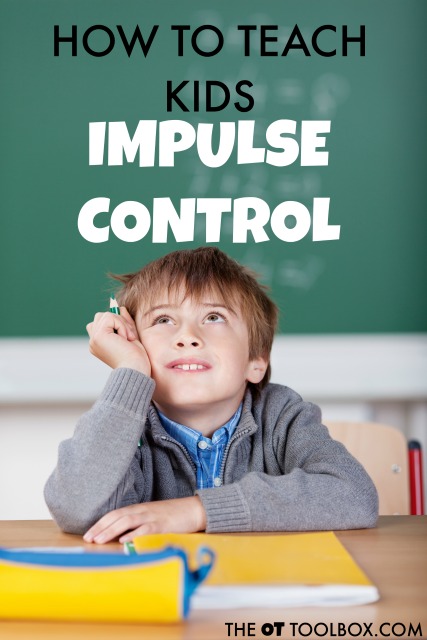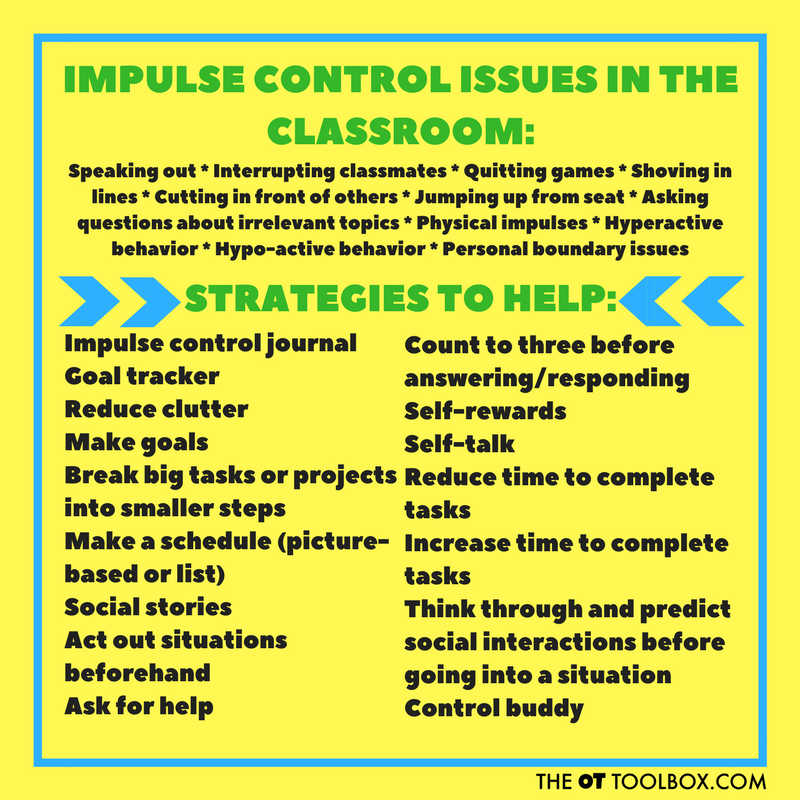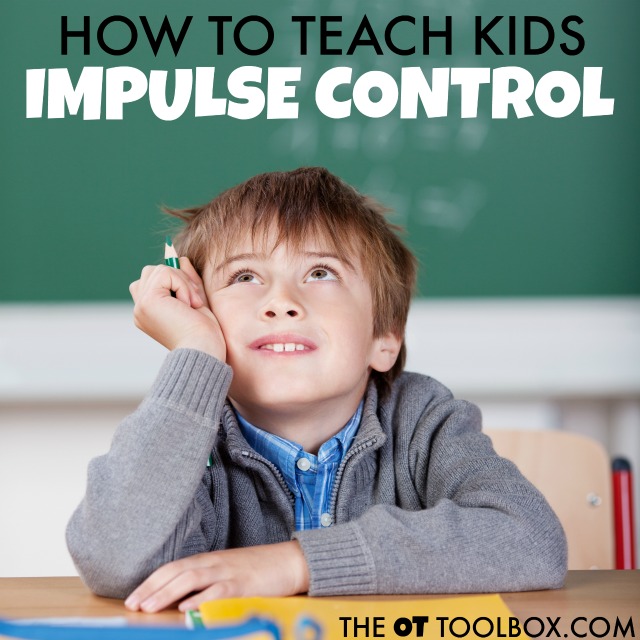Kids with executive functioning skill challenges may suffer from impulse control difficulties. The strategies indicated in this post are guides to help teach kids impulse control for improved attention, self-regulation, and learning in the classroom.
You might know of a child who just can’t help themselves in the classroom. They are the ones who are speaking out, interrupting, jumping up from their seat, and distracting their classmates. There are underlying reason behind these behaviors and it is important to consider those causes for impulse-related behaviors. It may be there are unmet sensory needs, difficulty with self-regulation, trouble expressing oneself, emotional causes, or other underlying areas.
More than likely, the kids that need help with impulse control are being addressed in some way by the child’s teacher or team in one way or several. But if impulses are something that need addressed, try the impulse control strategies outlined below.
You’ll be interested in all of our executive functioning skill activities.

Impulse control strategies for Kids
Parents, teachers, and therapists can use these strategies in different ways. Consider that every child is unique and what works for one child may not work for another. Likewise, it is very important to specifically design a strategy based on individualized assessment of the child.
Why is it difficult for kids to manage their impulses?
Children develop controlled impulses as part of their overall development. The very young child does not have these skills. In fact, there are those of us who have difficulty refraining from a second cookie as adults.
Impulse control requires will power, delayed gratification, and self-control. For the child who struggles with development, sensory processing, attention, physical limitations, cognitive delays, or social impairments, the ability to control ones impulses is very difficult.
These individuals are cognitively and automatically focused on the underlying needs. When other needs such as sensory or balance are the primary focus, it can be quite difficult to refrain from impulses.
Impulses seen in the classroom
Impulse control is part of development. Even adults with fully developed executive functioning skills struggle with impulse control skills. Examples include not going into the kitchen to grab a cookie when you know you have a bag of your favorite treats. Another example is controlling your urge to lounge and scroll social media for hours on end. Impulse control is hard!
But for kids, there is developmentally appropriate impulse control, and challenges in this area.
By developmentally appropriate impulse control, I’m talking about the student that knows it’s not appropriate to reach out and hit another student. That requires impulse control. In the classroom, there are many examples of impulse control (and lack of impulse control) that we see day in and day out.
Some of these are more reactive examples that occur in response to specific to situations, and others are common occurrences, simply because we are talking about kids here.
All of these examples of impulse issues in school can impact learning, safety, and education.
- Speaking out
- Interrupting classmates
- Quitting games
- Shoving in lines
- Cutting in front of others
- Jumping up from seat
- Asking questions about irrelevant topics
- Physical impulses
- Hyperactive behavior
- Hypo-active behavior
- Personal boundary issues
- Blurting out answers without waiting to be called on
- Interrupting teachers or classmates during discussions
- Difficulty waiting their turn in group activities or games
- Engaging in off-task behaviors instead of staying focused on assignments
- Acting without considering consequences, such as grabbing items without permission
- Difficulty following classroom rules or instructions
- Making impulsive decisions without thinking through the options
- Talking or socializing excessively when they should be working
- Difficulty staying seated during lessons or at their desk
- Being easily distracted by external stimuli or other students’ actions
- Overreacting emotionally to minor frustrations or setbacks
- Engaging in risky behaviors without considering safety, like climbing on furniture
- Struggling to regulate emotions, leading to outbursts or tantrums
- Being unable to resist the temptation of distractions like toys or electronic devices
- Experiencing challenges in transitioning between activities or tasks
Have you seen any of these examples of impulse control in the classroom?
How to teach kids impulse control:
- Reflective Drawing Journal Pages- Provide drawing journal pages for children to reflect on and pinpoint individual strategies for managing impulses effectively.
- Checklist Journal Lists- Offer journal lists for kids to create quick checklists focusing on their strengths, qualities, supports, areas of need, and insights related to impulse control.
- Coping Skills Worksheets- Utilize journal worksheets to help children pinpoint coping skills, feelings, emotions, and strategies that work best for them in managing impulses.
- Task and Goal Tracking Sheets- Supply daily and weekly tracking sheets for children to monitor tasks and goals, emphasizing progress in impulse control-related activities.
- Mindset, Vision, and Habit Pages- Incorporate pages focused on mindset, vision, and habits to assist kids in making a positive impact on their impulse control skills.
- Self-Evaluation Sheets- Provide self-evaluation sheets for children to reflect on instances when inhibiting impulses was challenging and to identify what alternative choices could have been made.
- Daily Tracker Pages- Offer daily tracker pages for children to record and monitor their daily activities, including instances where impulse control was exercised effectively.
- Chore and Task Lists- Create task lists to help children monitor chores and daily tasks, encouraging consistent practice of impulse control in everyday activities.
- Habit Improvement Journal Pages- Design journal pages specifically aimed at helping children improve new habits related to impulse control.
- Impulse Control Monitoring Charts and Guides- Provide charts and guides for monitoring impulse control behaviors, supporting children in building self-confidence through progress tracking.
- Strategy Journal Pages- Offer journal pages focused on strategies for self-reflection and self-regulation, empowering children to succeed both at home and in the classroom.
- Goal Setting Sheets- Supply goal sheets for children to set targets related to impulse control and work towards achieving them, fostering persistence and self-discipline.
- Mindset Improvement Tools- Introduce tools for improving mindset, helping children develop a set of coping strategies tailored to their needs and conducive to effective impulse control.
- Impulse control journal
- Goal trackers with themes
- Reduce clutter
- Make goals with actionable steps for short term (daily tasks)
- Break big tasks or projects into smaller steps
- Make a schedule (picture-based or list)
- Social stories- Here is information on how to write a social story.
- Act out situations beforehand
- Count to three before answering/responding.
- Teaching kids to stop and think on a regular basis
- Self-rewards
- Self-talk- Here are tools for positive self talk.
- Reduce time to complete tasks
- Increase time to complete tasks
- Think through and predict social interactions before going into a situation
- Control buddy
- Ask for help
- Habit tracker
- Teach about problem solving.
- Use a strategy checklist
- Carry a goal list
- Positive thought notebook
Executive functions all require the ability to pay attention. Read about the attention and executive functioning skill connection and the impact of attention on each of the executive functioning skills that children require and use every day.

Looking for more ways to address executive functioning needs? Try these strategies to help with organization, attention, or task initiation.

More tools for addressing attention needs in kids
When a child is easily “triggered” and seems to melt down at any sign of loud noises or excitement…
When you need help or a starting point to teach kids self-regulation strategies…
When you are struggling to motivate or redirect a child without causing a meltdown…
When you’re struggling to help kids explore their emotions, develop self-regulation and coping skills, manage and reflect on their emotions, identify their emotions, and more as they grow…
The Impulse control journal is a printable journal for kids that helps them to identify goals, assess successes, and address areas of needs. The Impulse Control Journal is a printable packet of sheets that help kids with impulse control needs.
Read more about The Impulse Control Journal HERE.
The Impulse Control Journal has been totally revamped to include 79 pages of tools to address the habits, mindset, routines, and strategies to address impulse control in kids.
- 30 Drawing Journal Pages to reflect and pinpoint individual strategies
- 28 Journal Lists so kids can write quick checklists regarding strengths, qualities, supports, areas of need, and insights
- 8 Journal worksheets to pinpoint coping skills, feelings, emotions, and strategies that work for the individual
- Daily and Weekly tracking sheets for keeping track of tasks and goals
- Mindset,Vision, and Habit pages for helping kids make an impact
- Self-evaluation sheets to self-reflect and identify when inhibition is hard and what choices look like
- Daily tracker pages so your child can keep track of their day
- Task lists to monitor chores and daily tasks so it gets done everyday
- Journal pages to help improve new habits
- Charts and guides for monitoring impulse control so your child can improve their self-confidence
- Strategy journal pages to help kids use self-reflection and self-regulation so they can succeed at home and in the classroom
- Goal sheets for setting goals and working to meet those goals while improving persistence
- Tools for improving mindset to help kids create a set of coping strategies that work for their needs

Colleen Beck, OTR/L has been an occupational therapist since 2000, working in school-based, hand therapy, outpatient peds, EI, and SNF. Colleen created The OT Toolbox to inspire therapists, teachers, and parents with easy and fun tools to help children thrive. Read her story about going from an OT making $3/hour (after paying for kids’ childcare) to a full-time OT resource creator for millions of readers. Want to collaborate? Send an email to contact@theottoolbox.com.








1 thought on “How to Teach Kids Impulse Control”
Thank you for the feedback! I’m working to correct that text 🙂
Comments are closed.